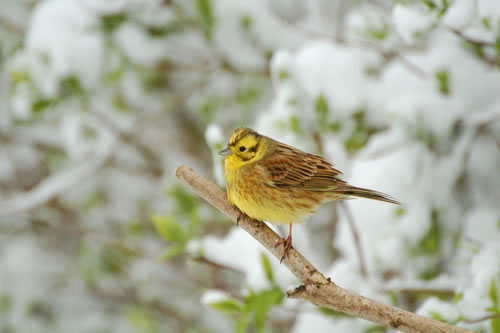
Filming of wildlife visiting pheasant feed hoppers during the leanest months of winter shows how simple feeding techniques could prevent some of our fastest declining farmland bird species from starving to death. A study by the Game & Wildlife Conservation Trust using a spy camera has revealed how the deliberate feeding of wild birds for a few critical weeks could be key to their survival.
In total, twenty seven species of wildlife were filmed visiting pheasant feeders during the study. Six of the bird species recorded are British birds of conservation concern, such as the yellowhammer. The numbers visiting the feeders increased substantially as winter progressed as other sources of food ran out. When the feeder visiting times for each species were added together, it was found that, collectively, non-game wild species fed for longer than the game species themselves.
Dr Alastair Leake, Policy Director at the Game & Wildlife Conservation Trust, said, "This research has important implications for wildlife during the ’hungry gap’ from February until late spring when birds struggle to survive. As winter went took hold food dwindled away in the open countryside, the spy camera revealed that visits to the feeders by all species increased significantly. This was most marked for songbirds. The number of yellowhammers visiting increased ten-fold over this season."
Many of our once-familiar farmland birds such as tree sparrow, grey partridge, and corn bunting have declined by more than 80 per cent in the last forty years. Most conservationists agree that a major factor in these declines is the increased scarcity of suitable food over the winter, resulting in fewer birds surviving.
Dr Leake said, "Most conservationists agree about the need to provide food by growing wild bird seed crops but these rarely provide enough sustenance through the ’hungry gap’. This study has a very clear message: if we wish to help our farmland birds, then providing them with additional grain either through game feed hoppers or by scattering seed could be critical. Farmers could potentially be rewarded for doing this through the Government’s Entry Level Stewardship Scheme. This would add a new critical measure to help conserve our farmland birds."
The study also showed that the location of the feeder attracted different species. Pigeons and crows for example preferred feeders set up in the open, while finches and sparrows preferred feeders placed close to thorny hedges.
"By positioning feeders in the right place we were able to target the species which need most help," said Dr Leake. "This shows that we can target wildlife recovery more effectively than we do at present. Given the right encouragement and this new information we are sure most farmers and land managers will want to go that extra mile to help wildlife on their land."
As well as being of value to declining farmland bird species, the spy camera revealed that pheasant feeders were also used by less threatened species such as dunnock and blackbird. Because these species do not form winter flocks, they only usually occurred in small numbers at each feeder. However, if a large number of smaller feeders were distributed widely, then this could also support a significant population of these species throughout the winter.
The study was carried out by John Szczur on the Game & Wildlife Conservation Trust’s Allerton Project demonstration farm at Loddington in Leicestershire. John Szczur explains the significance of this study, "Delivering food to farmland birds through feeders would undoubtedly help bridge the ’hungry gap’ and as a consequence has the potential to assist the recovery of their populations."
